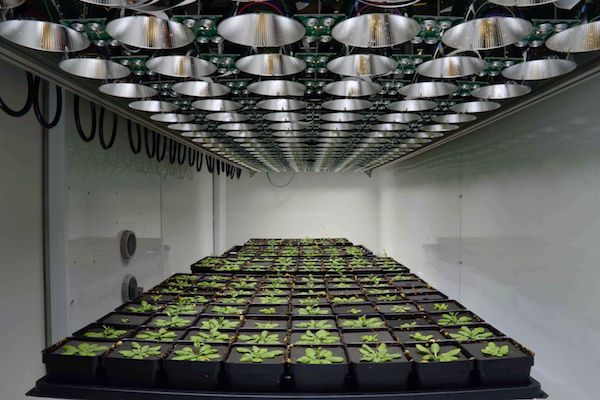DEPI Chambers
For decades, scientists have studied photosynthesis with sophisticated instruments under carefully controlled lab conditions. This approach has a provided detailed picture of the core components of this essential biological process that has powered and sustained life for over a billion years. However, controlled laboratory conditions may mask mechanisms plants have evolved to regulate photosynthesis in natural environments. For example, deleting genes that affect photosynthesis in some cases has no effect on growth under constant light intensities, but growth (and photosynthesis) under typical fluctuating intensities found outdoors is severely inhibited. In order to understand how photosynthesis operates and is regulated in nature, we need to perform laboratory experiments under ‘field-relevant’ conditions.
So why not just run experiments in the field? Obtaining reproducible results is more challenging. That is, when conditions in the field change constantly and unpredictably, it is unlikely that you will have exactly the same conditions from experiment to experiment. In addition, if the researcher is unlucky, field conditions may run counter to the experimental design (e.g. testing for drought tolerance during a wet calendar year), leading to wasted time and research funds.

By Kramer lab
What is the DEPI
Created in the lab of David Kramer, the Dynamic Environmental Photosynthetic Imager, or DEPI, was designed to bridge the gap between the laboratory and the field. DEPI can reproducibly simulate dynamic changes (or playback recorded field conditions) occurring in natural environments and continuously monitor the photosynthetic performance of plants in high throughput.
The core of DEPI consists of a lighting array of high power white LEDs capable of delivering up to full sunlight intensities (>2000 µmols photons m-2 sec-1) at a distance of 50 cm from soil level. Via computer control DEPI can precisely simulate the light intensity changes that occur in the field throughout a solar day. Enclosing this core apparatus inside a plant growth chamber allows experimental control other environmental parameters including:
- temperature (-5 to 45oC)
- humidity (20 to 70%)
- CO2 concentration (50 to 2000 ppm)
More importantly, plants can be measured by remote imaging without shifting them from the conditions under which they are grown. Using multiple cameras to simultaneously image all of the plants growing under the lighting canopy allows continuous monitoring with a time resolution that is not possible using robotic systems. For example in one DEPI, we routinely run experiments that simultaneously image as many as 250 Arabidopsis plants up to 130 times per day.
What parameters can DEPI track
DEPI typically captures chlorophyll fluorescence images that can be used to track multiple photosynthetic parameters including:
- Maximum efficiency (FV/FM)
- Photosynthetic efficiency (ϕII)
- Photoprotection (NPQ, qE, qI)
- Growth
Alternative imaging methods also allow monitoring of:
- Chloroplast movement (reflectance imaging)
- Leaf Movements (infrared imaging)
- Changes in stomatal conductance (thermal imaging)
The facilities
Currently CAAPP hosts 5 high capacity DEPI chambers (20 ft2 or ~2 m2) that can hold up to 8 flats containing as many as 31 pots (6.5 cm x 6.5 cm). Four of these large DEPI chambers have adjustable canopies that allow the lighting to be raised ~1 m above soil level to accommodate larger plant species.
In addition, CAAPP has 10 lower capacity chambers (1 to 2 flat capacity) smaller experiments, to allow more directed experiments.
Software tools for processing (Visual Phenomics), compiling and visualizing (OLIVER) data collected on the DEPI systems are available, free of charge to outside users.
Contact and booking
CAAPP is a self-supporting facility. Fixed-rate fees are based on the scope and duration of each experiment.
For more information, contact Jeff Cruz at cruzj@msu.edu or (517) 432-4619.
Contact
Dr. Jeffrey Cruz
Director of Plant Studies
cruzj@msu.edu
(517) 432-0071
Nathan Galbreath
Lab Technician/Scheduling
galbre12@msu.edu
(616) 550-1266